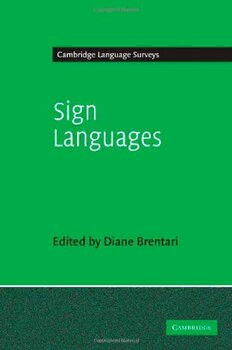
Sign Languages (Cambridge Language Surveys) PDF
Preview Sign Languages (Cambridge Language Surveys)
This page intentionally left blank SIGN LANGUAGES Whataretheuniquecharacteristicsofsignlanguagesthatmakethem sofascinating?Whathaverecentresearchersdiscoveredaboutthem, andwhatdothesefindingstellusabouthumanlanguagemoregen- erally? This thematic and geographic overview examines more than fortysignlanguagesfromaroundtheworld.Itbeginsbyinvestigating how sign languages have survived and been transmitted for genera- tions,andthengoesontoanalyzethecommoncharacteristicsshared bymostsignlanguages:forexample,howtheuseofthevisual(rather than the auditory) system affects grammatical structures. The final section describes the phenomena of language variation and change. Drawing on a wide range of examples, the book explores sign lan- guagesbotholdandyoung,fromBritish,Italian,AsianandAmerican toIsraeli,Al-SayyidBedouin,AfricanandNicaraguan.Writtenina clear, readable style, it is the essential reference for students and scholars working in sign language studies and Deaf studies, as well asanindispensableguideforresearchersingenerallinguistics. DIANE BRENTARI is Professor of Linguistics and Director of the ASLProgramatPurdueUniversity.SheistheauthorofAProsodic ModelofSignLanguagePhonology(1998)andhaspublishedwidelyin the area of sign language phonology and morphology. Her current researchinvolvesthecrosslinguisticanalysesofsignlanguages. CAMBRIDGE LANGUAGE SURVEYS Generaleditors P.Austin(UniversityofMelbourne) J.Bresnan(StanfordUniversity) B.Comrie(MaxPlanckInstituteforEvolutionaryAnthropology,Leipzig) S.Crain(UniversityofMaryland) W.Dressler(UniversityofVienna) C.J.Ewen(UniversityofLeiden) R.Lass(UniversityofCapeTown) D.Lightfoot(UniversityofMaryland) K.Rice(UniversityofToronto) I.Roberts(UniversityofCambridge) S.Romaine(UniversityofOxford) N.V.Smith(UniversityCollege,London) Thisseriesoffersgeneralaccountsofthemajorlanguagefamiliesofthe world,withvolumesorganizedeitheronapurelygeneticbasisorona geographicalbasis,whicheveryieldsthemostconvenientandintelligible groupingineachcase.Eachvolumecomparesandcontraststhetypological featuresofthelanguagesitdealswith.Italsotreatstherelevantgenetic relationships,historicaldevelopmentandsociolinguisticissuesarisingfrom theirroleanduseintheworldtoday.Thebooksareintendedforlinguists fromundergraduatelevelupwards,butnospecialknowledgeofthe languagesunderconsiderationisassumed.Volumessuchasthoseon AustraliaandtheAmazonBasinarealsoofwiderrelevance,asthefutureof thelanguagesandtheirspeakersraisesimportantsocialandpoliticalissues. Volumesalreadypublishedinclude ChineseJerryNorman ThelanguagesofJapanMasayoshiShibatani PidginsandCreoles(VolumeI:Theoryandstructure;VolumeII: Referencesurvey)JohnA.Holm TheIndo-AryanlanguagesColinMasica TheCelticlanguageseditedbyDonaldMacAulay TheRomancelanguagesRebeccaPosner TheAmazonianlanguageseditedbyR.M.W.Dixon andAlexandraY.Aikhenvald ThelanguagesofNativeNorthAmericaMarianneMithun TheKoreanlanguageHo-HimSohn AustralianlanguagesR.M.W.Dixon TheDravidianlanguagesBhadrirajuKrishnamurti ThelanguagesoftheAndesWillemAdelaarwithPieterMuysken TheSlaviclanguagesRolandSussexandPaulCubberley TheGermaniclanguagesWayneHarbert SignlanguagesDianeBrentari SIGN LANGUAGES edited by DIANE BRENTARI CAMBRIDGE UNIVERSITY PRESS Cambridge, New York, Melbourne, Madrid, Cape Town, Singapore, São Paulo, Delhi, Dubai, Tokyo Cambridge University Press The Edinburgh Building, Cambridge CB2 8RU, UK Published in the United States of America by Cambridge University Press, New York www.cambridge.org Information on this title: www.cambridge.org/9780521883702 © Cambridge University Press 2010 This publication is in copyright. Subject to statutory exception and to the provision of relevant collective licensing agreements, no reproduction of any part may take place without the written permission of Cambridge University Press. First published in print format 2010 ISBN-13 978-0-511-71301-9 eBook (NetLibrary) ISBN-13 978-0-521-88370-2 Hardback Cambridge University Press has no responsibility for the persistence or accuracy of urls for external or third-party internet websites referred to in this publication, and does not guarantee that any content on such websites is, or will remain, accurate or appropriate. CONTENTS Listoffigurespageviii Listoftables xiii Listofcontributors xv Listofsignlanguageabbreviations xix Notationalconventions xxi 1 Introduction DianeBrentari 1 I HISTORY AND TRANSMISSION 17 2 TransmissionofsignlanguagesinNorthernEurope PennyBoyesBraemandChristianRathmann 19 3 TransmissionofsignlanguagesinLatinAmerica ClaireRamseyandDavidQuinto-Pozos 46 4 TransmissionofsignlanguagesintheNordiccountries BritaBergmanandElisabethEngberg-Pedersen 74 5 TransmissionofsignlanguagesinMediterraneanEurope JosepQuer,LauraMazzoniandGaliniSapountzaki 95 6 TransmissionofsignlanguagesinAfrica DorothyLuleandLarsWallin 113 7 TransmissionofPolishsignsystems PiotrWojda 131 II SHARED CROSSLINGUISTIC CHARACTERISTICS 149 8 Notationsystems HarryvanderHulstandRachelChannon 151 9 Verbagreementinsignlanguagemorphology GauravMathurandChristianRathmann 173 v vi Contents 10 Functionalmarkersinsignlanguages SandroZucchi,CarolNeidle,CarloGeraci,QuinnDuffy andCarloCecchetto 197 11 Clausestructure RoniceMu¨llerdeQuadrosandDianeLillo-Martin 225 12 Factorsthatformclassifiersigns ElisabethEngberg-Pedersen 252 13 Handshapecontrastsinsignlanguagephonology DianeBrentariandPetraEccarius 284 14 Syllablestructureinsignlanguagephonology TommiJantunenandRitvaTakkinen 312 15 Grammaticalizationinsignlanguages ShermanWilcox,PaoloRossiniandElenaAntinoro Pizzuto 332 16 Thesemantics–phonologyinterface RonnieB.Wilbur 355 17 Nonmanuals:theirgrammaticalandprosodicroles RolandPfauandJosepQuer 381 III VARIATION AND CHANGE 403 18 SignlanguagesinWestAfrica VictoriaNyst 405 19 SignlanguagesintheArabworld KindaAl-FityaniandCarolPadden 433 20 VariationinAmericanSignLanguage CeilLucasandRobertBayley 451 21 SociolinguisticvariationinBritish,Australian andNewZealandSignLanguages AdamSchembri,KearsyCormier,TrevorJohnston, DavidMcKee,RachelMcKeeandBencieWoll 476 22 VariationinEastAsiansignlanguagestructures SusanFischerandQunhuGong 499 23 Crosslinguisticvariationinprosodiccues GladysTang,DianeBrentari,CarolinaGonza´lez andFelixSze 519 Contents vii 24 Deixisinanemergingsignlanguage MarieCoppolaandAnneSenghas 543 25 Thegrammarofspaceintwonewsignlanguages CarolPadden,IritMeir,MarkAronoffandWendySandler 570 Notes 593 References 618 Index 670 FIGURES 1.1 ThethreecomponentsoftheASLlexiconwithrepresentative vocabulary.page11 6.1 ABUSEwiththemouthpattern‘vu’oftheLugandaword onvuma. 119 6.2 VERYwiththemouthpattern‘nyo’oftheLugandaword ‘nnyo’. 119 6.3 NOT-YETwiththemouthpattern‘bdo’oftheSwahiliword bado. 120 6.4 FINISHwiththemouthpattern‘fsh’oftheEnglishwordfinish. 121 6.5 DEAFaccompaniedbythereducedmouthpattern‘df’ oftheEnglishworddeaf. 121 8.1 PhotographofASLsign. 152 8.2 DrawingofASLsign. 152 8.3 Englishwrittenword. 152 8.4 Commoninternationallyrecognizedwritingsymbol. 152 8.5 SuttonSignWritingsymbol. 152 8.6 IPA(InternationalPhoneticAlphabet)notationofEnglish spokenword. 152 8.7 HamNoSyssymbolsforASLTHREE. 152 8.8 SignTypCodingSystementriesforASLTHREE. 153 8.9 Relationshipofformtomeaninginspeechorsign. 156 8.10 Possiblerelationshipsbetweenformandmeaningforwriting systemsandtheirparallelspoken/signedsystem. 156 8.11 PartialfeaturetreesforBEAUTIFULandFLOWER(rotated). 170 9.1 ASKintwoofitsforms. 174 9.2 Backwardsverbs. 178 9.3 PluralformsofASK. 181 9.4 Targetsforagreementforms. 183 9.5 Acceptablevs.awkwardformsofagreement. 186 9.6 PersonAgreementMarker(PAM)inDGS. 188 10.1 Illustrationofexample(6):‘Giannihasboughtahouse.’ 200 10.2 IllustrationofASLsignFINISH. 203 10.3 Illustrationofexample(18):‘JohnhasvisitedMary.’ 205 11.1 Topicnonmanualmarking(tm1). 234 viii
